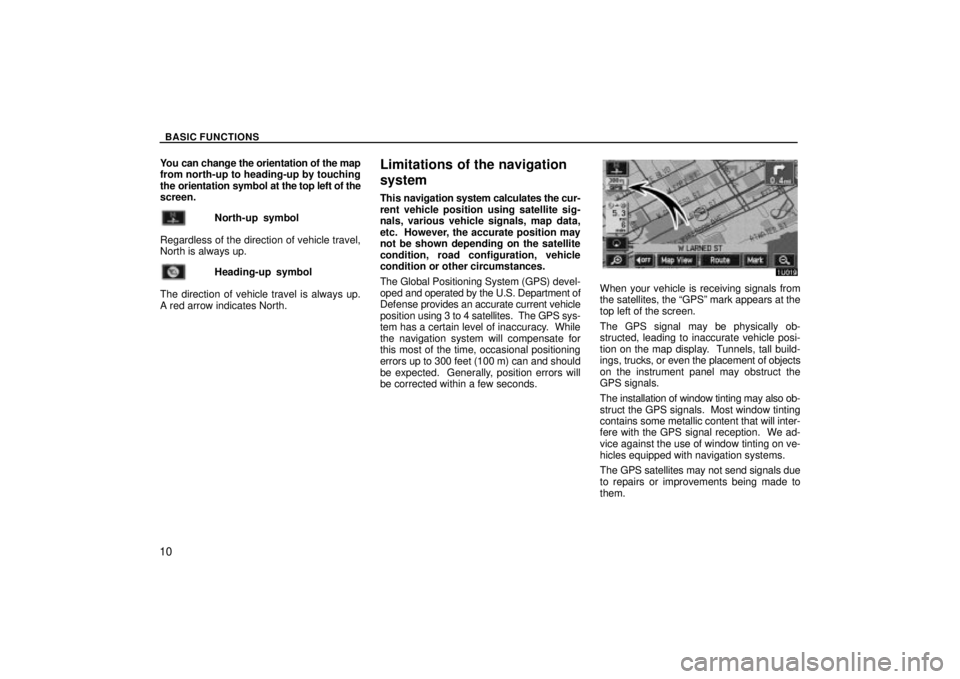sat nav TOYOTA SOLARA 2004 Accessories, Audio & Navigation (in English)
[x] Cancel search | Manufacturer: TOYOTA, Model Year: 2004, Model line: SOLARA, Model: TOYOTA SOLARA 2004Pages: 141, PDF Size: 2.03 MB
Page 1 of 141

i
Introduction
Thank you for your purchase of the Navigation System. Please read this \
manual carefully to ensure proper use. Keep this manual
in your vehicle at all times.
The Navigation System is one of the most technologically advanced vehicle a\
ccessories ever developed. The system receives satellite signals
from the Global Positioning System (GPS) operated by the U.S. Departme\
nt of Defense. Using these signals and other vehicle sen sors, the
system indicates your present position and assists in locating a desired desti\
nation.
The navigation system is designed to select efficient routes from your present starting location to your destination. \
The syst em is designed
to direct you to a destination that is unfamiliar to you in an efficient manner. The system uses the maps of DENSO. The calcu lated routes
may not be the shortest nor the least traffic congested. Your own personal local knowledge or short cutº may at times be fast er than the calcu-
lated routes.
The navigation system's database includes about 75 Point of Interest categories to allow you to\
easily select destinations such as restaurants
and banks. If a destination is not in the database, you can enter the stre\
et address or a major intersection close to it and the system will guide
you there. The system will provide both a visual map and audio instruct\
ions. The audio instructions will announce the distanc e remaining
and the direction to turn in approaching a fork or intersection. These voi\
ce instructions will help you keep your eyes on the road and are timed
to provide enough time to allow you to maneuver, change lanes or slow down.
Please be aware that all current vehicle navigation systems have certain limitatio\
ns that may affect their ability to perform properly.
The accuracy of the vehicle's position depends on the satellite condition, road configuration, vehic\
le condition or other circu mstan-
ces. For more information on the limitations of the system, refer to pages \
10 through 12.
Page 20 of 141

BASIC FUNCTIONS
10
You can change the orientation of the map
from north-up to heading-up by touching
the orientation symbol at the top left of the
screen.
North-up symbol
Regardless of the direction of vehicle travel,
North is always up.
Heading-up symbol
The direction of vehicle travel is always up.
A red arrow indicates North.
Limitations of the navigation
system
This navigation system calculates the cur-
rent vehicle position using satellite sig-
nals, various vehicle signals, map data,
etc. However, the accurate position may
not be shown depending on the satellite
condition, road configuration, vehicle
condition or other circumstances.
The Global Positioning System (GPS) devel-
oped and operated by the U.S. Department of
Defense provides an accurate current vehicle
position using 3 to 4 satellites. The GPS sys-
tem has a certain level of inaccuracy. While
the navigation system will compensate for
this most of the time, occasional positioning
errors up to 300 feet (100 m) can and should
be expected. Generally, position errors will
be corrected within a few seconds.
When your vehicle is receiving signals from
the satellites, the GPSº mark appears at the
top left of the screen.
The GPS signal may be physically ob-
structed, leading to inaccurate vehicle posi-
tion on the map display. Tunnels, tall build-
ings, trucks, or even the placement of objects
on the instrument panel may obstruct the
GPS signals.
The installation of window tinting may also ob-
struct the GPS signals. Most window tinting
contains some metallic content that will inter-
fere with the GPS signal reception. We ad-
vice against the use of window tinting on ve-
hicles equipped with navigation systems.
The GPS satellites may not send signals due
to repairs or improvements being made to
them.